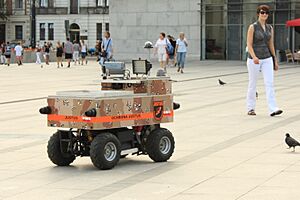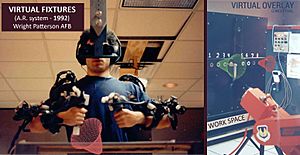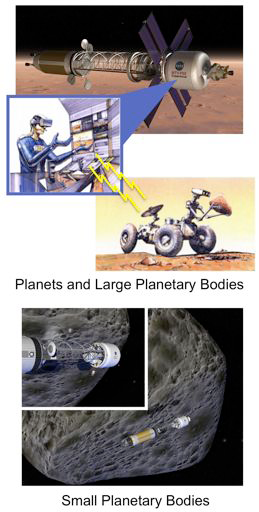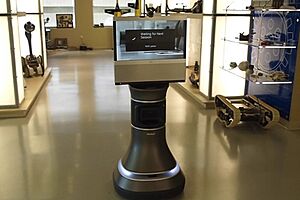Telerobotics facts for kids
Telerobotics is a cool part of robotics. It is all about controlling robots from far away. Imagine guiding a robot without being right next to it! This often uses television, wireless networks like Wi-Fi, or special cables.
Telerobotics combines two main ideas. One is teleoperation, which means operating a machine from a distance. The other is telepresence, which makes you feel like you are actually there with the robot.
Contents
Controlling Robots from Afar
Teleoperation is like using a remote control. But it is for more complex machines, like robots. People use this term a lot in science and technology. It means a person is operating a device from a distance. This can be a robot or any other machine.
Teleoperation is different from telepresence. Telepresence makes you feel like you are really in the robot's location. You might see, hear, and even feel things as if you were there. One early system, called Virtual Fixtures, let people feel like they were touching objects. Even though a robot was doing the work far away.
A telemanipulator is a robot arm or device. A human operator controls it remotely. Sometimes, your commands go straight to the robot. Think of a radio-controlled toy plane. Other times, the robot follows a path you set. This is useful if there are delays in communication. Or if the robot needs to avoid obstacles on its own.
These devices help people control robots from a distance. They are sometimes called telecheric robotics.
To control a robot from far away, you need to see what it sees. A camera on the robot sends pictures back to you. It is important that the camera view helps you control the robot easily. New technology makes this possible with good speed and clear pictures.
You might even use a head mounted display (like VR goggles). This lets you control the camera by just moving your head. It feels like you are looking around yourself.
Sometimes, there can be a small delay in the system. Or the picture might not be super clear. This can make it feel a bit strange. It might even make you feel a little dizzy or unwell. This happens if what you see does not match your body's movements.
It is important for the robot to respond smoothly to your commands. If there are delays or jerky movements, it can be frustrating. It can also make it harder to do tasks.
Robots used to have fewer ways to move. This made them easier to control. But now, computers are much better. So, robots can have more ways to move. This makes them seem smarter and more like humans. It also lets you control them more directly with your own motions.
How We Control Them: Interfaces
An interface is how you tell the robot what to do. It can be as simple as a computer screen, mouse, and keyboard. This is cheap and often used for robots controlled over the internet. A joystick can also make it easier to move the robot around.
Special telepresence setups use a head-mounted display. This gives you a clear view from the robot's perspective. They also have special joysticks and buttons. These controls are designed to feel natural to use.
Other systems combine virtual reality with live video. Imagine walking on a special treadmill. As you walk, the robot moves in the real world. You might also see extra information. This could be heat images or maps.
Robots in Action: Amazing Uses
Exploring Space with Robots
Most space exploration has used telerobots. This is true except for the Apollo program where humans landed on the Moon. For example, telescopes in space are controlled remotely. The Russian Lunokhod-1 rover explored the Moon. Humans on Earth drove it in real time. There was a small delay of about 2.5 seconds.
Modern Mars rovers like Mars exploration rovers and Curiosity are also telerobots. Scientists on Earth program their tasks each day. The International Space Station (ISS) has a robot arm called Dextre. It helps astronauts with tasks outside. A humanoid robot named Robonaut is also on the ISS. It helps with experiments.
NASA has ideas for future space missions. Humans could orbit a planet like Mars. Then, they could control powerful robots on the surface. This would be like being there without landing. This idea is called HERRO. It stands for Human Exploration using Real-time Robotic Operations.
Being There Without Being There: Telepresence Robots
Video calls are very common now. This has led to many telepresence robots. These robots help people feel more present when they cannot be somewhere in person. They are used in offices, homes, and schools. The robot can move or look around. The person controlling it tells it what to do.
There are two main types of these robots.
- Desktop telepresence robots hold a phone or tablet. They can pan and tilt the screen. This lets the remote person look around a room.
- Drivable telepresence robots have a screen on a moving base. They can drive themselves around. They can even map out a space. This helps them avoid obstacles. They can drive between rooms and find their charging stations.
These robots are very helpful for children with long-term illnesses. They can use a robot to attend school from home. This helps them stay connected with friends and teachers. It also helps them feel less lonely.
Underwater Adventures: Marine Robots
Robots are also used for work deep underwater. These are called remotely operated vehicles (ROVs). They work in places too deep or dangerous for divers. They can repair oil platforms. They can also attach cables to sunken ships. The famous wreck of the Titanic was explored by an ROV.
Robots Helping Doctors: Medical Uses
Robots are also used in medicine. They help with robotic surgery. A surgeon can use a robot to work inside the body. They make tiny holes for the robot's tools. This means less cutting for the patient.
Other Cool Robot Jobs
Robots can handle dangerous materials. For example, they can move radioactive items safely.
Telerobotics has even been used in art! The Telegarden project let people control a robot through the internet. This robot tended a real garden.
Learn More About Robots
- Astrobotic Technology
- Dragon Runner, a military robot built for urban combat
- Lunokhod
- Medical robot
- Military robot
- Remote control vehicle
- Remote manipulator
- Robonaut
- Smart device
- Spirit rover
- Snowplow robot
- UWA Telerobot





